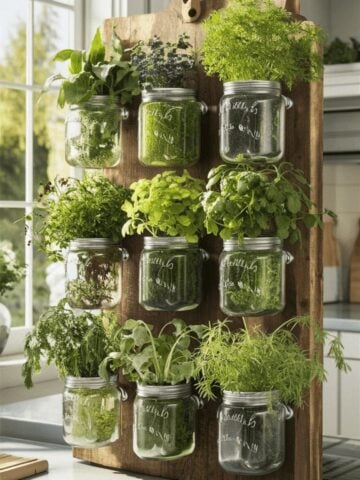Explore the transformative world of landscaping with my in-depth blog post. Learn how to enhance your outdoor space, increase property value, and embrace eco-friendly practices for a sustainable, breathtaking sanctuary.
Disclaimer: this post may contain affiliate links, and every purchase made through these links will give me a small commission (at absolutely no extra cost for you!) AS AN AMAZON ASSOCIATE AND REWARDSTYLE MEMBER, I EARN FROM QUALIFYING PURCHASES. See Privacy Policy for additional info.
Nature has a unique way of casting a tranquil spell over our homes and our lives. The rustling leaves, the vibrant colors of flowers in full bloom, and the texture of the earth underfoot combine in an outdoor symphony that speaks directly to our senses.
Landscaping isn't just about beautifying your outdoor space; it's about creating a symphony where plants, water features, and stonework come together in perfect harmony. Here's how you can transform your outdoor space into a personal oasis through the art of landscaping.

Understanding Landscaping
At its core, landscaping is the act of altering the visible features of an area of land to create an environment that is both attractive and functional. This can include planting, altering the existing terrain, and building structures such as patios, pathways, and water features.
The Benefits of Landscaping
- Aesthetic Appeal: A well-landscaped yard can dramatically enhance the curb appeal of your home.
- Increased Property Value: Landscaping can increase a property’s value by up to 20%.
- Environmental Impact: Thoughtful landscaping can help reduce erosion, purify the air, and provide a habitat for local wildlife.
- Health Benefits: Gardens and green spaces can reduce stress, promote physical activity, and provide a space for relaxation.
- Entertainment and Recreation: A landscaped yard can serve as the perfect backdrop for gatherings, play, and outdoor dining.
Planning Your Landscape
Before you break ground, it's crucial to have a plan. Here are key components to consider when planning your landscape:
- Analyzing Your Space: Take stock of your yard’s topography, soil type, climate, and existing vegetation. Understand the light patterns throughout the day, as this will influence plant selection and placement.
- Defining Areas: Think about how you want to use your space. You might allocate areas for dining, lounging, and growing vegetables or flowers.
- Choosing a Style: Your landscape design should complement the architectural style of your home. Whether it's formal, informal, English garden, or modern minimalism, the style should reflect your personal taste.
- Creating a Color Palette: Decide on the colors that will best suit your space. This could be a range of greens, a burst of vibrant colors, or a monochromatic scheme.
- Selecting Plants: When choosing plants, consider their growth habit, maintenance needs, and how they'll interact with existing plants and structures.
Implementing Your Design
Transforming your plan into reality requires patience and effort. Here’s how you can proceed:
- Start with Hardscaping: Begin with the non-living features such as pathways, patios, and retaining walls. These serve as the foundation of your landscape design.
- Soil Preparation: Enrich your soil with compost and ensure proper drainage to create a healthy environment for plants to thrive.
- Plant Selection: Choose a mix of trees, shrubs, perennials, and annuals to create diversity and year-round interest.
- Installation: Plant trees and shrubs first, followed by perennials and annuals. Ensure proper spacing to give plants room to grow.
- Irrigation: Consider an irrigation system that suits your garden's needs, whether it’s a drip system, sprinklers, or a simple hose.
Maintaining Your Landscape
A stunning landscape is a living, breathing entity that requires ongoing attention:
- Regular Pruning: Keep your plants in shape and encourage growth with regular pruning.
- Weed Control: Stay on top of weeds to keep your garden looking tidy and to prevent them from sapping nutrients from other plants.
- Mulching: Apply mulch to suppress weeds, retain soil moisture, and prevent erosion.
- Fertilizing: Feed your plants with the right fertilizers to promote healthy growth.
- Seasonal Cleanup: Prepare your garden for the changing seasons with appropriate cleanup and plant protection.
Sustainable Landscaping
With sustainability becoming increasingly important, consider these eco-friendly practices for your landscape:
- Drought-Tolerant Plants: Choose native or drought-resistant plants that require less water.
- Rainwater Harvesting: Collect rainwater for irrigation to conserve water.
- Eco-friendly Materials: Use recycled or sustainable materials for hardscaping.
- Pollinator Gardens: Include plants that attract bees, butterflies, and other pollinators to support biodiversity.
Conclusion
Landscaping is more than just a means of beautification; it's an extension of your living space that invites you to interact with nature intimately. Whether you're creating a haven for wildlife, a place for children to explore, or a serene spot for personal reflection, landscaping allows you to sculpt the natural world into a reflection of your vision.
Embrace the journey of transforming your outdoor space, and let the art of landscaping reveal the hidden potential of your home’s green canvas.
Until next time,
















Leave a Reply